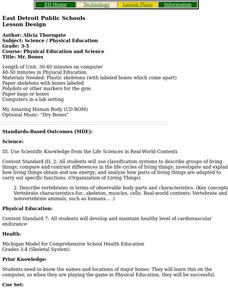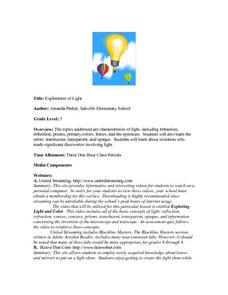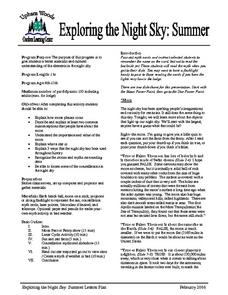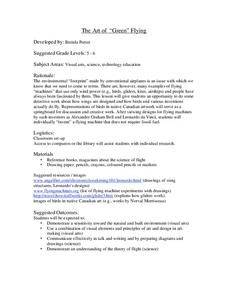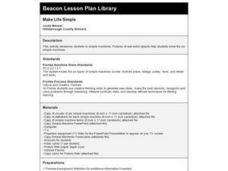Curated OER
A Stroll Down Memory Lane
Learners examine the functionality of different types of computer memory (RAM) as a springboard to researching the definitions, uses and functions of different common computer terms. The class creates a computer terminology guide.
Curated OER
Light and Shadows
Students explore shadows. For this shadow and light lesson, students predict what will happen to a shadow when the light source is dimmed. Students participate in a whiteboard interactive lesson.
Curated OER
Exploring Vaccines
Students explain in a written format how vaccination works and how it draws upon the natural immunity. They differentiate between vaccinations and immunizations. Students identify a number of illnesses that can be prevented by the use of...
Curated OER
Visiting Museums
Learners visit museums and gather information about dinosaur habitats, survival needs, and how they met these needs.
Curated OER
Micro-organisms
Students learn what a micro-organism is. In this micro-organism lesson, students understand that micro-organisms may be too small to see. Students learn microorganisms could be bacteria, fungi, something beneficial or a harmful microbe....
Curated OER
Food Chains
Learners investigate how food chains work. For this food chains lesson, students construct a food web for a pear tree habitat. The interactive whiteboard is an optional tool in this lesson.
Curated OER
To Be or Not to Be - Abiotic/Biotic Factors
Students define and compare/contrast abiotic and biotic factors presented while using web cameras on the Web World Wonders website.
Curated OER
Mr. Bones
Students play CD-ROM game My Amazing Human Body, and participate in relay game in Phys. Ed. where they put together skeleton on which body parts are labeled.
Curated OER
Protein Synthesis Activities
Students participate in a teacher-guided activity to teach about protein synthesis. Student roles include one person as the DNA molecule, another is a single stranded sequence of complementary mRNA.
Curated OER
Water Microbes and Human Health
Students research the possible sources and human health effects of microbes found in recreational and drinking water. They explore the range of negative outcomes of contact with contaminated recreational and drinking water by creating...
Curated OER
Endangered Species
Students define extinction, name four animals and two plant species that are extinct, list three reasons why animals and plants become extinct, and create ways that would help prevent extinction.
Curated OER
The 400-acre wood
For this forest planning lesson plan, students visit the 400-acre wood website and work in groups to learn about the specific aspects of forest development. Students create, label and color a forest planning map and present their...
Curated OER
Trends Forecasting
Learners practice trends forecasting to predict the weather. In this forecasting lesson plan, students learn how meteorologists predict the weather by looking at weather trends. They then predict their own forecast, analyze the results,...
Curated OER
Survival of the Fittest Microbes
Students explore the harsh conditions of Spain's Rio Tinto River and research the microbes that nonetheless manage to thrive there. They synthesize their knowledge by creating a reality television show set in the Rio Tinto with microbes...
Curated OER
Physical or Chemical? That Is the Question
Students find examples of physical and chemical changes using the five Web World Wonders camera sites.
Curated OER
Exploration of Light
Fifth graders observe the video, Exploring Light and Color. They access a website to create their own light show. They conduct lab experiments to investigate refraction, reflection,and other light-related topics.
Curated OER
Lessons: Food Web
Students use an interactive web-based food web game to gain familiarity with tropic levels and interactions. They already understand that in an ecosystem there are four basic tropic levels: producers, primary consumers, secondary...
Curated OER
Getting into Hot Water
Young scholars discuss the effect of global warming on bodies of water after reading "An Icy Riddle as Big as Greenland" from The New York Times. Students work in groups to research topics related to global warming and Greenland's...
Curated OER
Exploring the Night Sky: Summer
Learners explain how moon phases occur. They describe and explain at least two common misconceptions that people have about the moon. Students explain what a star is. They explain 3 ways that the night sky has been used throughout history.
Curated OER
The Art of "Green" Flying
Learners create an airship that doesn't use fossil fuel. In this flying lesson, students research different types of flying machines that only use wind power. They discuss invention designs by Alexander Graham Bell and Leonardo Da Vinci...
Curated OER
Make Life Simple
Students examine six simple machines by looking at pictures of real world objects.
Curated OER
Simple Machines
Students explain how simple machines work and design their own machine. They use the Internet for research.
Curated OER
Classifying Vertebrates
Second graders study animal characteristics and classification. For this animal characteristics and classifications lesson, 2nd graders determine how to classify vertebrates which include mammals, reptiles, amphibians, birds, and fish....
Curated OER
Acids and Bases: Together again!
Students identify principles behind acid-base reactions. They predict factors that may affect an acid-base reaction. Students identify questions and concepts that guide scientific investigations.







